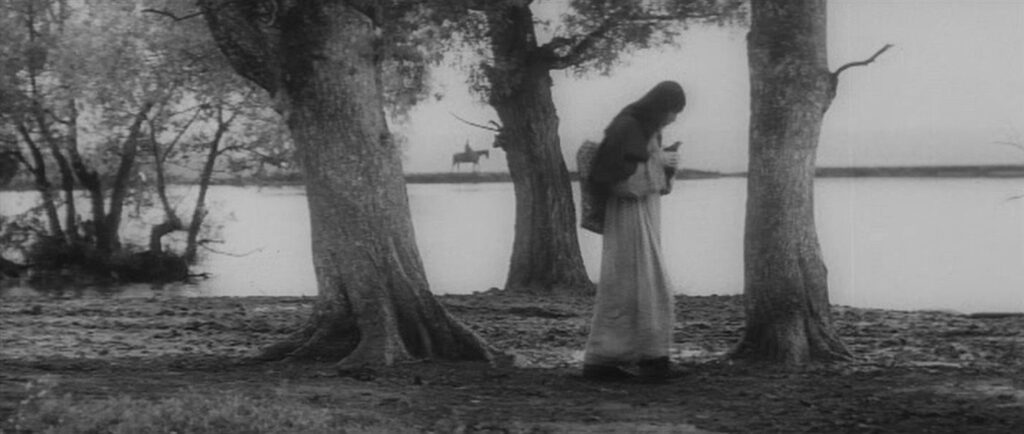
Andrei Rublev
1966, directed by Andrei Tarkovsky
Nevermind that Andrei Rublev is a monumental production over three hours long, spanning the whole first quarter of the fifteenth century, opening questions about religion, violence, and other weighty topics. Its substance can be summarized in the difference between two scenes: the balloonist in the prologue and the bell casting in the final episode. The film invites the comparison, bracketing the icon painter’s biography with these two passages, each set around an orthodox church. The balloon and the bell are both pinnacles of medieval technology, both roughly the same size and color, both tethered before their dramatic first use by impressive arrays of parallel ropes.
The differences between the balloon and the bell are more pronounced than their similarities. The balloon is a soft object controlled by the hot air inside it, whereas the bell is hard and influences the air outside in all directions. The balloon is quiet, even dramatically so as it lifts its pilot over the river and the floodplains, while the bell is loud enough to fill the countryside. The balloon is launched from the top of a church and falls to the ground, but the bell is molded in an earthen pit and will rise to the top of a church.
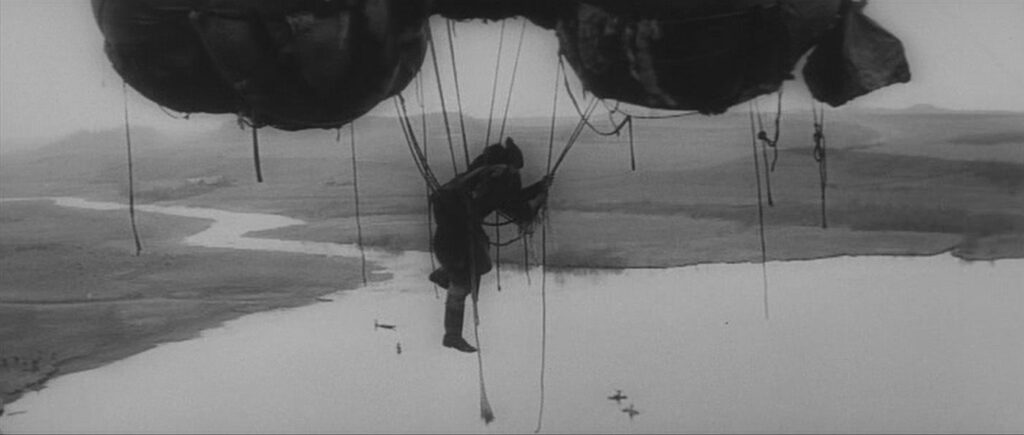
More important yet is the contrast between the two figures who create the objects. One is a grown man, the other barely past boyhood. One fails, left dead or immobile after crash landing the balloon, but the other succeeds spectacularly, surpassing his own expectations as much as those of the Grand Duke’s Italian guests who mock the bell’s chances of ringing. But Andrei Rublev is not a heartwarming tale of triumph. More to the point than either creator’s failure or success is their attitude and their influence. The balloonist soars over the landscape, taking in what Russians in 1400 must have regarded as a God-like view of the crowds below. The bellcaster’s son Boriska shows none of the balloonist’s detachment. He immerses himself in a muddy pit, mixing with common workers, unafraid to dirty himself either literally or with crude manners. He throws his heart and body into the work, pushing himself to exhaustion, risking more than anyone realizes until he confesses to Rublev that he was bluffing all along. His father, the old bellcaster, had died without passing on his secrets.
The proud balloonist does more than fail at his endeavor; he also fails to influence anyone. Controlled aviation would not be achieved for centuries to come, and there’s no sign that Rublev witnesses the event to learn from it. The bellcaster’s orphaned son, on the other hand, living in a shack and verging on starvation, manages not only to create a magnificent bell that lifts the spirits of hundreds – he also inspires the legendary icon painter to create his finest work.
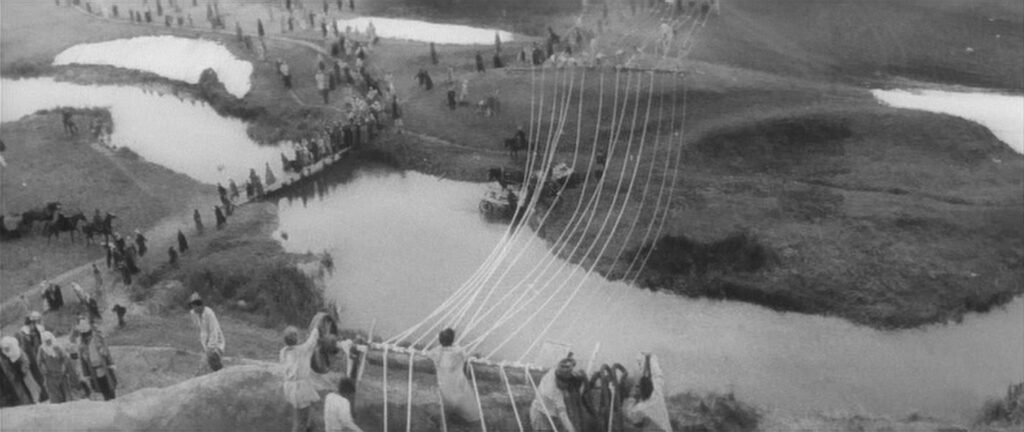
Together these two scenes argue for a particular definition of art, and we’re meant to understand that after witnessing the bellcasting Rublev finally discovers his own art. In Tarkovsky’s view art must arise from humility, from the sweat, blood, and messiness of earthly life. The balloonist aspires to a greatness that separates him from the life around him and ultimately from his own life. He wishes to travel through the clean air, untainted by the muddy earth below, whereas Boriska finds ecstasy sliding down a muddy palisade and rolling in wet clay. This same contrast between high and low, between the lofty and the earthly, runs through Tarkovsky’s subsequent films, and it’s rooted in the Gospel of Matthew (“The last shall be first, and the first last”).
If we can grasp the essence of Andrei Rublev in these two scenes, we might wonder why all the footage in between is necessary. In fact it’s all part of the same argument. The clue to its purpose is in the original seven-part structure, before Tarkovsky cut 20 minutes from the film and created an eighth part by separating the passion play from the second episode.
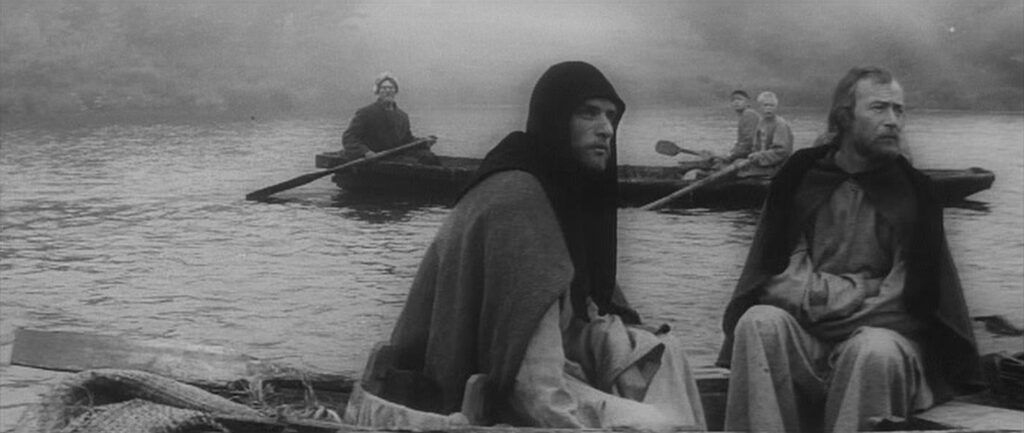
In the original 206-minute version, each episode – excluding the balloonist’s prologue and the colorful coda that showcases the results of Rublev’s artistry – corresponds to one of the Seven Cardinal Vices:
- In Episode One (The Jester) a fool performs for a crowd taking shelter from the rain. He mocks the pride of the aristocratic Boyars, but in showing off he exposes his own pride, and Kirill, in his contemptuous pride, reports the jester to authorities who arrest and imprison him.
- In Episode Two (Theophanes the Greek) Kirill expects to become the Greek painter’s assistant, but when Theophanes invites Rublev instead, Kirill leaves the monastery in an envious rage.
- In Episode Three (The Holiday) a naked pagan lures Rublev to a festival where another woman seduces him. The next day he watches lustfully as the woman swims away to escape arrest.
- In Episode Four (The Last Judgment) Rublev and his assistants stand idle in Dormition Cathedral (even the name suggests sloth), with no inspiration to paint the Last Judgment until news of the Grand Duke’s cruelty compels them to begin work.
- Episode Five (The Raid) is a brutal outpouring of anger as Tatars sack Vladimir in league with the Grand Duke’s brother. Rublev himself gives in to wrath, killing a soldier who tries to rape Rublev’s adopted holy fool Durochka.
- Episode Six (Love) begins during a famine as Rublev reprimands Durochka for eating dung. A gang of Tatars rides by, and one snags Durochka to be his wife, luring her with food. Given the high price she pays, her hunger is tantamount to gluttony.
- In Episode Seven (The Bell) the Grand Duke’s commission of a huge bell and Boriska’s brazen demands for more and more silver both mimic the sin of avarice.
The seven parts thus reflect the Seven Deadly Sins, but considering the film’s interest in art, they also point to the seven days of creation. Just as the bellcaster’s son must endure weeks of rain, sweat, dirt, and fire to find his artistry, Rublev comes to understand that his own art must arise out of the sin and chaos of his times. Though he’s already a renowned painter by the second episode, we never see him in the act of painting except when he splatters paint in frustration on the blank wall of Dormition Cathedral. Instead of watching him create, we see him observing, experiencing the “soil” of sin around him and sometimes stooping to participate in it. After the casting of the bell he realizes that the point of creation is not to rise above the baseness of the world, but to transform it from within.
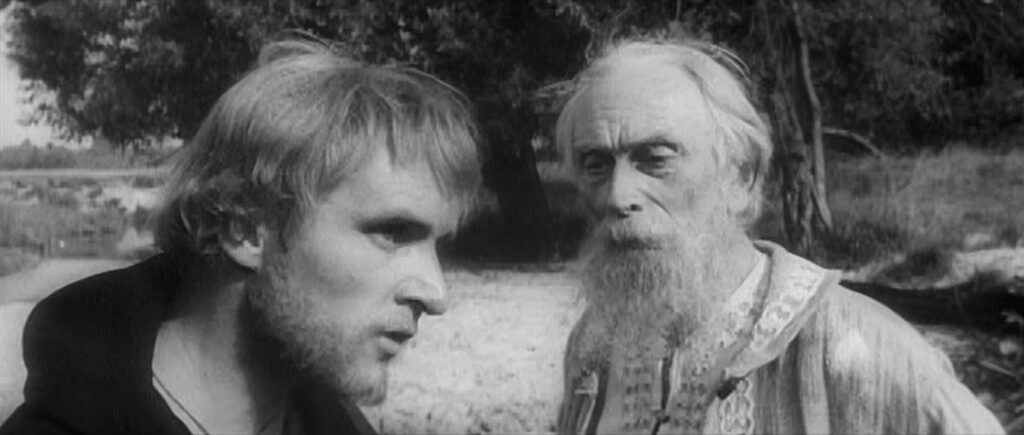
By 1971 Tarkovsky had cut the film to 186 minutes, approving the shortened version which dispensed with the seven-part structure. He may have felt that its emphasis on the seven sins or the days of creation was too programmatic. In any case, removing the structural cue did not remove the substance of the episodes, and Rublev’s art still emerges, like the bell, from his own “earthen pit” of sin and agony.
Just as the movie makes special note of the balloonist’s lack of influence, and conversely Boriska’s influence, on the great painter, Tarkovsky is always interested in art’s ability to influence its audience. Rublev’s position as an observer mirrors our own as viewers, implying that we too, by enduring the horrors, tedium, and vulgarity of the movie’s three hours, should also emerge prepared to transform our world for the better.
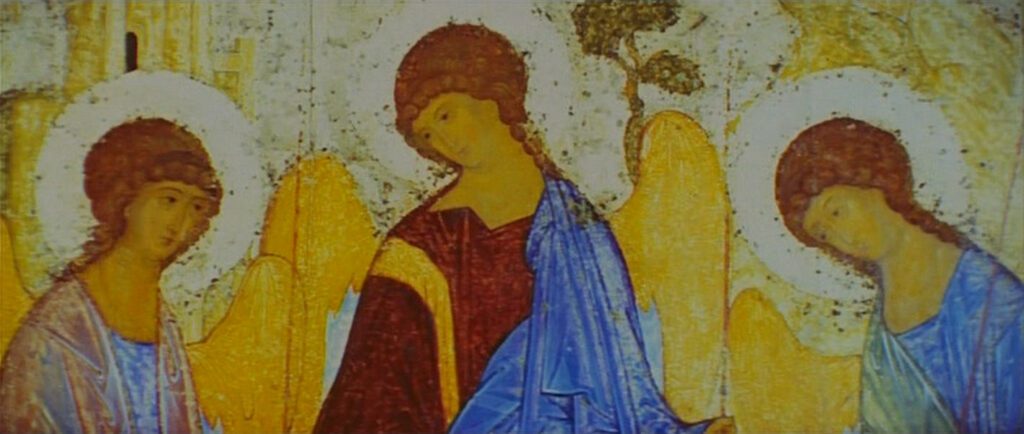
The greatest surprise at the end is that Kirill proves to be at least as exemplary as Boriska and Andrei. He’s not as conspicuous, but his story defines the movie’s arc as much as Rublev’s does. He starts out as a proud icon painter, leaves his companions behind in a fit of envy, and resurfaces in the penultimate act, humbled and begging for readmittance to the monastery. The father superior lets him in under penalty of copying Holy Scripture fifteen times – a life sentence given his failing eyesight. After the bellcasting he implores Rublev to return to painting. Again, true creative influence arises out of humility. Kirill’s part in changing Rublev’s mind is overshadowed by Boriska’s, but if we’ve followed the movie’s logic we should appreciate the glorious end in the story of this poor monk. Lacking his own talent, near death and defeated by life, having dreamt of becoming a great artist, he finally surpasses his youthful ambition when he awakens Rublev’s immortal talent. The fact that someone else will paint the great icons he dreamt of painting is immaterial – they wouldn’t exist without him.
CONNECTIONS:
Exit Smiling – Character whose artistic ambition is realized and surpassed but in a humbler form
Vampyr – Argument against art as something aloof from earthly matters
Ladies in Retirement – Seven deadly sins as a structural device
The Hand of the Devil – Seven deadly sins as a structural device
The Third Man – Overhead view as a God’s-eye perspective
Orphée – Argument that an artist’s work must be grounded in earthly reality
Monsieur Hulot’s Holiday – Seven-part structure; reference to Genesis; creation from humility; movie revised after release
A Man Escaped – Idea that great works arise from a vulgar origin
Vivre sa vie – Reversal of connoted value in high and low; argument for bringing the idea of art down to earth
Au hasard Balthazar – Character gifted at end with a kind of glory that rewards humility
Solaris – Balloon(s) in the opening scene; contrast between high and low
Stalker – Inspiration favors the low over the high (bellcaster & Stalker)
Nostalghia – Contrast between an act of pride in a high place and an act of faith in a low place
The Sacrifice – Effective action comes from a low place
Breaking the Waves – Seven parts with a prologue and epilogue; tale of inspiration emerging from sin; bell(s) ringing at the end
The Wind Will Carry Us – Reversal of connoted value in high and low
Dancer in the Dark – Protagonist’s road to creativity in seven parts